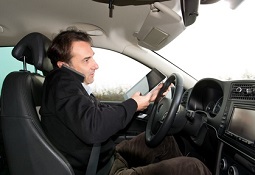 When we say the risks for distracted driving are piling up, we mean it in a couple different ways.
When we say the risks for distracted driving are piling up, we mean it in a couple different ways.
For one, studies are showing new kinds of riskiness for distracted drivers when they’re behind the wheel. Secondly, authorities are starting to make sure those risky drivers pay for being distracted.
So if you think that you’re a driver that can still be safe when you’re distracted, think again. And rethink it some more if it seems like driving distracted isn’t something that police have caught onto yet.
Risks Still Exist with Voice-Activated Technology
Distracted driving is a relatively new traffic safety concern, and one of the prevailing beliefs in public discussions has been that drivers need to use their hands and eyes properly while driving.
Automakers’ response has been making more in-car technology voice-activated to minimize drivers’ use of their hands and eyes.
But new research highlights the evolving nature of distracting driving: now, drivers simply aren’t using their brains properly. Voice-activated systems cause cognitive distraction, according to a recent study from the AAA Foundation for Traffic Safety, that are just as risky as technology that distracts a driver’s eyes and hands.
“The AAA Foundation challenges the notion that drivers are safe and attentive as long as their eyes are on the road and their hands are on the wheel,” the group said in its report, adding that its study reveals the previously unstudied problem of “mental distractions” while driving.
The study also revealed other alarming findings, including the fact that more than half of surveyed drivers still believe that hands-free technology is acceptable.
Police Try ‘New Tools and Tactics’
New York has been at the forefront of the fight against distracted driving, thanks in large part to a very public call against the traffic danger from Gov. Andrew Cuomo in 2011.
Two summers ago, the governor kicked off an enforcement campaign against texting while driving when the violation was made a primary offense, meaning police can stop any driver they suspect of texting. (Secondary offenses cannot stand on their own and can only be attached to a primary offense.)
By last summer, the governor said the campaign had led to a “major increase in tickets.”
This summer, Gov. Cuomo was at the microphone again to announce new strategies in the continued fight against distracted driving.
New York State Police now use Concealed Identity Traffic Enforcement (CITE) cars, a fleet of unmarked vehicles that are “built on higher platforms,” which help officers spot violators.
Texting while driving is one of the harder distracted driving offenses to enforce because authorities need to visually identify the violation while it is occurring.
“The State Police is now using new tools and tactics to enforce that law,” Governor Cuomo said last week about the hardened law. “I am hopeful that every driver who got a ticket for looking at their phone instead of the road gets the message that this reckless behavior won’t be tolerated.”
There aren’t just worries about civilian distracted drivers on the road. Some of those distracted drivers are in police departments—and something’s being done about it.
Fort Wayne police in Indiana were the first in the U.S. to use technology to bolster officer safety in their own squad cars, according to city officials.
Using a system called Archangel II, keyboard, trackpad, and touch screen functions become inoperable when the car reaches a preset speed. For patrolmen, the system discourages distractions while driving and still allowing emergency calls to come through.
Last week, city officials announced that the technology would be expanded to all cars used by city departments, serving the age-old adage that the best way to lead is by example.
Lawmakers Try New Laws, Penalties
This summer, New York Gov. Cuomo not only announced new details on law enforcement tactics against distracted driving, but also publicized harsher penalties that will charge five points to a driver’s license for distracted driving-related offenses, akin to the number of points charged for speeding recklessly.
Such points come with moving violations make it hard to find cheap prices on car insurance because insurers often deem them a justifiable reason for higher premiums.
More lawmakers across the nation are hardening penalties for distracted driving offenses.
Last week, Connecticut’s governor finalized a bill that required at least one point be charged for a driving violation stemming from cellphone use.
Sponsoring Rep. Fred Camillo (R-Greenwich) called distracted driving “the number one health and safety hazard on our roads and highways.” The bill went into effect this in July.
In Virginia this month, a newly passed law also went into effect that not only upped the fine for texting while driving but also made the violation a primary offense.
Traffic safety officials there estimate that, in 2012, more than 1 out of every 5 traffic crashes were linked to driver distractions.
In addition, Hawaii and Florida both passed bans on texting while driving in May, drawing applause from federal officials. Currently, 41 states and the District of Columbia have laws that bar drivers from texting behind the wheel.
“We are making a difference in the fight against distracted driving through a combination of good laws, tough and consistent enforcement, and extensive public education,” David Strickland, NHTSA administrator, said in a statement about Hawaii’s new law.